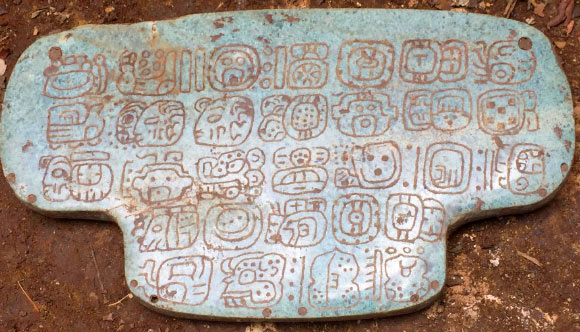A team of archaeologists led by Geoffrey Braswell, Professor of Anthropology at the University of California, San Diego, has found a remarkable artifact at a Maya archaeological site in Belize: a large piece of carved jade once belonging to an ancient Maya king.

The Maya jade pendant is inscribed with 30 hieroglyphs. The jade stone itself is from the mountains of Guatemala, southwest of Belize. Image credit: Geoffrey Braswell, University of California, San Diego.
The artifact — a T-shaped jade pendant worn on a king’s chest during key religious ceremonies — was found at Nim Li Punit, a small site in the Toledo District of Belize inhabited between 150 and 850 CE.
The jewel is remarkable for being the second largest Maya jade found in this country to date.
Prof. Braswell and University of California, San Diego graduate students Maya Azarova and Mario Borrero, along with a crew of local people, were excavating a palace built around the year 400 when they found a collapsed, but intact, tomb.
Inside the tomb, which dates to about 800 CE, were 25 pottery vessels, a large stone that had been flaked into the shape of a deity and the precious jade pectoral.
The pendant measures 7.4 inches (18.8 cm) wide, 4.1 inches (10.4 cm) high and just 0.3 inches (0.8 cm) thick.
“Sawing it into this thin, flat form with string, fat and jade dust would have been a technical feat. But what makes the pendant even more remarkable is that it’s the only one known to be inscribed with a historical text,” Prof. Braswell said.
“Carved into the pendant’s back are 30 hieroglyphs about its first owner.”
The pendant is in the shape of a T. Its front is carved with a T also. This is the Mayan glyph ‘ik`,’ which stands for ‘wind and breath.’
“It was buried in a curious, T-shaped platform. And one of the pots discovered with it, a vessel with a beaked face, probably depicts a Maya god of wind,” Prof. Braswell said.
“Wind was seen as vital by the Maya. It brought annual monsoon rains that made the crops grow. And Maya kings — as divine rulers responsible for the weather — performed rituals according to their sacred calendar, burning and scattering incense to bring on the wind and life-giving rains.”
According to the inscription on its back, the pendant was first used in 672 CE in just such a ritual.
Two relief sculptures on large rock slabs at Nim Li Punit also corroborate that use. In both sculptures, a king is shown wearing the pendant while scattering incense, in 721 and 731 CE, some 50 and 60 years after the pendant was first worn.
“By the year 800, the pendant was buried, not with its human owner, it seems, but just with other objects. Why? The pendant wasn’t a bauble, it had immense power and magic,” Prof. Braswell said.
The inscription on the back of the pendant is perhaps the most intriguing thing about it.
The text is still being analyzed by Prof. Braswell’s colleague, Dr. Christian Prager from the University of Bonn. And Mayan script itself is not yet fully deciphered or agreed upon.
But team’s interpretation of the text so far is this: the pendant was made for the king Janaab’ Ohl K’inich.
In addition to noting the artifact’s first use in 672 CE for an incense-scattering ceremony, the hieroglyphs describe the king’s parentage. His mother, the text implies, was from Cahal Pech, a distant site in western Belize. The king’s father died before aged 20 and may have come from somewhere in Guatemala.
“It also describes the accession rites of the king in 647 CE and ends with a passage that possibly links the king to the powerful and immense Maya city of Caracol, located in modern-day Belize,” Prof. Braswell said.
“It tells a political story far from Nim Li Punit,” he added.
“Cahal Pech, the mother’s birthplace, for example, is 60 miles (97 km) away. That’s a five-hour bus ride today, and back then would have been many days’ walk — through rainforest and across mountains. How did the pendant come to this outpost?”
Prof. Braswell believes the pendant is telling us about the arrival of royalty at Nim Li Punit, the founding of a new dynasty.
“The writing on the pendant is not particularly old by Maya standards, but it’s the oldest found at Nim Li Punit so far. It’s also only after the pendant’s arrival that other hieroglyphs and images of royalty begin to show up on the site’s stelae, or sculptured stone slabs,” he said.
“It could be that king Janaab’ Ohl K’inich himself moved to Nim Li Punit. Or it could be that a great Maya state was trying to ally with the provinces, expand its power or curry favor by presenting a local king with the jewel. Either way, the writing on the pendant indicates ties that had been previously unknown.”
Prof. Braswell and Dr. Prager recently published a paper in the journal Ancient Mesoamerica detailing the pendant’s significance.
A paper detaining the excavations will be published in an upcoming issue of the Journal of Field Archaeology.
_____
Christian M. Prager & Geoffrey E. Braswell. 2016. Maya Politics and Ritual: An Important New Hieroglyphic Text on a Carved Jade from Belize. Ancient Mesoamerica 27 (2): 267-278; doi: 10.1017/S095653611600033X
This article is based on a press-release from the University of California, San Diego.







